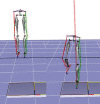Effects of Patellofemoral Pain Syndrome on Changes in Dynamic Postural Stability during Landing in Adult Women
- PMID: 35592870
- PMCID: PMC9113904
- DOI: 10.1155/2022/7452229
Effects of Patellofemoral Pain Syndrome on Changes in Dynamic Postural Stability during Landing in Adult Women
Abstract
Background: This study investigated the effects of lower limb movements on dynamic postural stability (DPS) during drop landing in adult women with patellofemoral pain syndrome (PFPS).
Methods: Thirty-eight adult women were recruited and divided into two groups, the PFPS group and the control group. The study participants performed a single-leg drop landing from a 30 cm box, and their lower limb movements and DPS were measured. Differences between groups were examined using independent sample t-tests. In addition, stepwise multiple linear regression was used to examine the kinematic parameters that contribute to the DPS.
Results: The PFPS group had significantly lower hip flexion, internal rotation, knee flexion, ankle external rotation, pelvic oblique, tilt, rotation, and higher hip abduction, knee valgus, and ankle plantarflexion. In terms of DPS, the PFPS group had a significantly higher anteroposterior and a lower mediolateral than that of the control group. In the control group, regression analysis revealed a controlled anteroposterior using knee flexion, while the PFPS group controlled mediolateral through ankle plantarflexion.
Conclusions: Patients with PFPS experienced more shock on their knee joint during landing than patients in the control group with greater anteroposterior instability and lower mediolateral instability.
Copyright © 2022 Chanki Kim et al.
Conflict of interest statement
The authors declare that there is no conflict of interest regarding the publication of this paper.
Figures




Similar articles
-
Propulsion phase of the single leg triple hop test in women with patellofemoral pain syndrome: a biomechanical study.PLoS One. 2014 May 15;9(5):e97606. doi: 10.1371/journal.pone.0097606. eCollection 2014. PLoS One. 2014. PMID: 24830289 Free PMC article.
-
Trunk, pelvis, hip, and knee kinematics, hip strength, and gluteal muscle activation during a single-leg squat in males and females with and without patellofemoral pain syndrome.J Orthop Sports Phys Ther. 2012 Jun;42(6):491-501. doi: 10.2519/jospt.2012.3987. Epub 2012 Mar 8. J Orthop Sports Phys Ther. 2012. PMID: 22402604
-
Eccentric hip muscle function in females with and without patellofemoral pain syndrome.J Athl Train. 2009 Sep-Oct;44(5):490-6. doi: 10.4085/1062-6050-44.5.490. J Athl Train. 2009. PMID: 19771287 Free PMC article.
-
Biomechanics Associated with Patellofemoral Pain and ACL Injuries in Sports.Sports Med. 2015 Sep;45(9):1325-1337. doi: 10.1007/s40279-015-0353-4. Sports Med. 2015. PMID: 26130304 Review.
-
Relationship Between Jump-Landing Kinematics and Lower Extremity Overuse Injuries in Physically Active Populations: A Systematic Review and Meta-Analysis.Sports Med. 2020 Aug;50(8):1515-1532. doi: 10.1007/s40279-020-01296-7. Sports Med. 2020. PMID: 32514700
Cited by
-
Is Postural Control Affected in People with Patellofemoral Pain and Should it be Part of Rehabilitation? A Systematic Review with Meta-analysis.Sports Med Open. 2022 Dec 12;8(1):144. doi: 10.1186/s40798-022-00538-4. Sports Med Open. 2022. PMID: 36504326 Free PMC article.
-
Effectiveness of combining a proximal strengthening exercise program and foot orthosis on pain and performance among women with patellofemoral pain syndrome and a pronated foot: study protocol for a randomized clinical trial.Trials. 2025 Mar 10;26(1):81. doi: 10.1186/s13063-025-08787-w. Trials. 2025. PMID: 40065357 Free PMC article.
References
LinkOut - more resources
Full Text Sources

